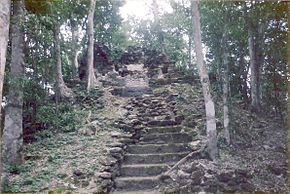Nakbé

Temple at Nakbe
|
|
| Location | Petén Department, Guatemala |
|---|---|
| Region | Petén Basin |
| Coordinates | 17°40′58.08″N 89°49′59.16″W / 17.6828000°N 89.8331000°W |
| Type | Settlement |
| History | |
| Periods | Early Preclassic to Late Preclassic |
| Cultures | Maya civilization |
| Site notes | |
| Condition | In ruins |
Nakbe is one of the largest early Maya archaeological sites. Nakbe is located in the Mirador Basin, in the Petén region of Guatemala, approximately 13 kilometers south of the largest Maya city of El Mirador. Excavations at Nakbe suggest that habitation began at the site during the Early Formative period (c. 1400 BC) and continued to be a large site until its collapse during the Terminal Formative period (100–200 BC). The fall of Nakbe and El Mirador took place at roughly the same time.
The site was first discovered in 1930 by aerial photos taken of the region, but excavations of the site did not take place until 1962. Archaeologist Ian Graham was the first person to start excavations, but it wasn’t until the 1980s and 1990s that real excavation began by UCLA's Institute of Geophysics and Planetary Sciences, and the Institute of Anthropology and History of Guatemala. The combined efforts of these two groups resulted in the RAINPEG Project, which was headed by Dr. Richard D. Hansen. One of the main focuses of the RAINPEG Project was to investigate the limestone quarries in the area of Nakbé.
Nakbe was a key site to the Maya because of its extensive quarry system of limestone, a key element to the building of the many large temples.
The RAINPEC Project spent much of its energy excavating and studying the tools that were used in limestone excavation and preparation. They had unearthed 23 tools including bifacial axes, picks, and hammer stones, all of which were made of chert. The researches then replicated these tools to see what the methods of mining and shaping the limestone were. Not only did they come to realize that chert was an excellent tool for precision cutting of limestone, but these experiments shed light on how the Maya not only harvested the limestone, but how they shaped it to use for their elaborate complex architectural building.
The site center has yielded large quantities of middle Preclassic ceramics. Pottery found at the site includes red-on-cream items, multi-colored bowls, incised bowls, narrow-necked jars with coarsely painted bands, and a wide variety of monochrome vessels that are red, cream, or black. Many tecomates (jars with narrow openings but without necks) were found. Also found were numerous fragments of figurines depicting a wide variety of human and animal forms. Shells through which holes were ground were a common find at the site. Many were Strombus shells, a type of artifact unique to the first part of the middle Preclassic at Nakbe, Uaxactun, Tikal, and other sites where similarly dated deposits are located.
...
Wikipedia


